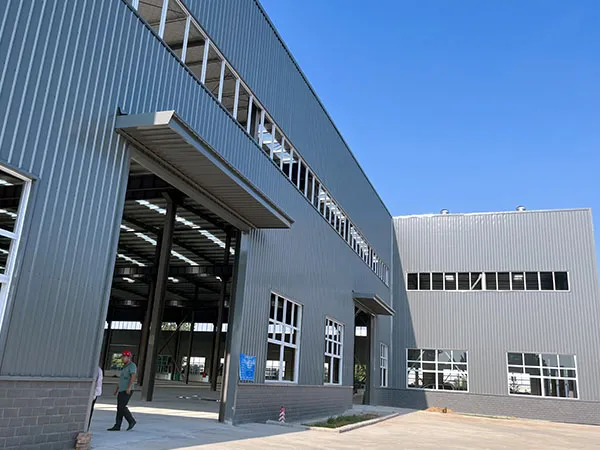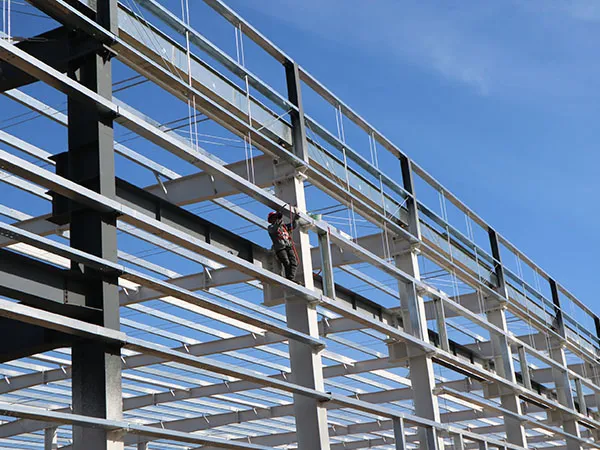Time:2025-05-06 03:24:22 Source:Sanjian Meichen Steel Structure
In the modern industrial system, steel is the undisputed backbone. From towering factory buildings to intricate equipment supports, industrial steel structures, with their exceptional strength and adaptability, bear the heavy weight of production. However, these massive structures are not always secure. In harsh industrial environments, they face constant threats such as corrosion, fatigue, and natural disasters.
Data shows that improper steel structure maintenance costs the world hundreds of billions of dollars annually, directly impacting corporate profits and potentially leading to production halts and even catastrophic accidents. Therefore, scientific and systematic maintenance of industrial steel structures is more than just a cost-effective measure; it is a strategic investment that safeguards the lifeblood of production, extends asset life, and ensures the safety of personnel. This article will delve into the various aspects of industrial steel structure maintenance to help you build an indestructible "Great Wall of Steel."
Industrial steel structures, like a company's core assets, endure a variety of tests day after day. Understanding the potential "symptoms" they may encounter is the first step to effective maintenance.
1. Corrosion: The Silent Devourer
Corrosion is the most common and most harmful "killer" of steel structures. It is not a single phenomenon, but a combination of multiple chemical and electrochemical processes:
Atmospheric Corrosion: In humid, rainy industrial atmospheres with high concentrations of acidic gases (such as SO2 and NOx), electrochemical reactions occur on the surface of steel, forming rust. This not only damages the appearance but also gradually reduces the effective cross-sectional area of the steel.
Electrochemical Corrosion: When two dissimilar metals come into contact or when there are surface inhomogeneities on the steel (such as welds), the presence of electrolytes (water, moisture) creates a galvanic couple, accelerating the corrosion of the active metal.
Stress Corrosion Cracking (SCC): Under the combined action of tensile stress and specific corrosive media, cracks form and propagate within the metal. This can occur even when the macroscopic stress level is low. Microbial Corrosion: The metabolic products of certain bacteria and microorganisms in specific environments (such as moist soil or areas exposed to sewage) can accelerate the corrosion of steel.
Corrosion not only reduces the bearing capacity of steel but can also cause loosening of joints, equipment failure, and even leakage and environmental pollution.
2. Structural Deformation and Instability: A Hidden Danger
Steel structures subjected to long-term loads, temperature fluctuations, or unexpected impacts can deform beyond their design tolerances, leading to instability.
Overload and Fatigue: Continuous overload or repeated dynamic loads can cause fatigue damage to steel, generating microcracks that gradually propagate and eventually lead to component fracture.
Temperature Stress: Drastic temperature fluctuations in industrial environments cause steel structures to expand and contract. If improperly restrained, these can generate significant temperature stresses, resulting in bending, warping, or connection failure.
Uneven Foundation Settlement: Uneven foundation settlement can cause uneven stress on the steel structure, leading to overall tilt, localized deformation, or cracks. Buckling Instability: After reaching a certain compressive stress, a slender's compression rod or thin-walled member may suddenly bend laterally or deform locally, losing its load-bearing capacity. For example, this can occur with the overall buckling of a steel column or the local buckling of a web.
3. Welding Defects and Connection Failure: The Weak Link
Welding is a critical link in steel structure connections, but welding quality issues and failure of connectors are common hidden dangers.
Welding Defects: Welding defects such as porosity, slag inclusions, incomplete penetration, cracks, and undercuts can weaken weld strength and create stress concentration points.
Bolt Loosening or Shearing: Long-term vibration, fatigue, or improper installation can cause high-strength bolts to loosen, inadequate preload, and even shear failure.
Rivet Corrosion and Shearing: Rivets in older riveted structures may fail due to corrosion or fatigue.
4. External Impacts and Natural Disasters: Unpredictable Damage
Collision Impact: Accidental collisions with forklifts, cranes, or other heavy equipment can cause local deformation or fracture of steel columns and beams.
Fire: Steel's strength decreases dramatically at high temperatures, leading to structural collapse.
Wind and Earthquakes: Extreme wind loads or earthquakes can cause complete or partial structural damage.

Preventive maintenance is fundamental. Through regular inspections and planned maintenance, problems can be nipped in the bud.
Regular Cleaning: Remove dust, oil, and chemical residue from steel structure surfaces to reduce the adhesion of corrosive media. Cleaning is particularly important in areas with high levels of corrosive gases.
Anti-Corrosion Coating Maintenance: Regularly inspect coating integrity and sand, remove rust, and reapply any areas that are peeling, blistered, or worn. Selecting the appropriate anti-corrosion coating is crucial.
For example, epoxy zinc-rich primers provide excellent rust prevention, epoxy micaceous iron intermediates enhance film thickness and barrier properties, and fluorocarbon topcoats provide long-term weather resistance and decorative properties.
Fastener Inspection and Replacement: Regularly inspect the tightness of fasteners such as bolts and rivets, tightening or replacing loose or corroded fasteners.
High-strength bolts should be preloaded.
Structural Inspection: Visually inspect for obvious deformation, cracks, weld defects, component damage, or connection failure. Pay particular attention to critical load-bearing components and areas prone to corrosion. Drainage system maintenance: Ensure that the drainage systems on roofs, platforms, and ground are unobstructed to avoid water accumulation that may lead to increased local corrosion.
Predictive Maintenance (PdM): Intelligent “Health Monitoring”

Predictive maintenance represents a new trend in maintenance technology. It leverages advanced monitoring technologies and data analysis to assess equipment and structural conditions in real time, predict potential failures, and enable intervention before they occur.
Vibration analysis: Vibration sensors are installed to monitor the vibration signals generated by rotating machinery (such as cranes and fans), analyzing their frequency and amplitude to determine whether bearing wear, imbalance, or misalignment exist, thereby preventing vibration from transmitting to the steel structure and causing fatigue damage.
Infrared thermal imaging: Infrared thermal imaging cameras are used to detect abnormal temperature rises at steel structure connections, electrical equipment, or pipelines, identifying problems such as overheated electrical joints, damaged insulation, or clogged pipelines.
Ultrasonic testing (UT): Utilizing the propagation characteristics of ultrasonic waves in materials, UT can detect internal weld defects (such as slag inclusions, pores, and cracks), component thickness reduction (caused by corrosion), and bolt preload.
Magnetic particle testing (MT)/penetrant testing (PT): Used to detect surface or near-surface defects (such as cracks and slag inclusions) in steel structures.
Acoustic Emission (AE) testing: Real-time monitoring of transient elastic waves generated by materials during load or deformation, used to detect dynamic processes such as crack propagation and corrosion cracking within structures.
Strain monitoring: Strain gauges are installed at key locations to monitor the stress and strain of steel structures in real time, assessing their response under actual loads and identifying abnormal loading or structural damage.
Drone inspections: Drones equipped with high-definition cameras or thermal imaging cameras conduct rapid and comprehensive visual inspections of steel structures at high altitudes, in complex, or hazardous areas, improving efficiency and reducing risk.
These technologies enable companies to transition from traditional scheduled maintenance (preventive maintenance) to condition-based maintenance (CBM), achieving more precise and efficient maintenance.
Deepening of anti-corrosion strategies
Heavy-Duty Anti-Corrosion Coating System: We select specialized heavy-duty anti-corrosion coating systems for different corrosive environments (such as marine climates and chemical corrosion), and strictly control the pre-coating surface treatment (sandblasting and rust removal grade Sa2.5 or higher) and coating process.
Cathodic Protection Technology: For buried or submerged steel structures, sacrificial anodes or impressed current methods are used. By applying direct current or sacrificing a more active metal, the electrochemical state of the steel is altered to prevent corrosion.
Material Selection: During the initial design phase, materials with excellent corrosion resistance, such as stainless steel and weathering steel, are selected for specific corrosive environments.
Structural reinforcement and repair technology

When steel structures are damaged, affecting their bearing capacity or functionality, they require reinforcement and repair.
Cross-Section Reinforcement: Steel plates or steel sections are added to existing components through welding or bolting to increase their cross-sectional dimensions and improve bearing capacity.
Steel Plate Reinforcement: Steel plates are bonded to damaged components using high-strength structural adhesive to increase their stiffness and strength.
Carbon Fiber Reinforcement (CFRP): Utilizing the high strength and lightweight properties of carbon fiber, these materials are impregnated with resin and bonded to the surface of steel structures to repair cracks or improve the tensile and shear resistance of components.
Reinforcement by Reversing Load Transfer: Adding supports, tie rods, or braces changes the way the structure is loaded, redistributing the load to undamaged or reinforced components.
Welding Repair: After removing weld defects or component cracks and preparing the grooves, repairs are performed using standard welding procedures.
Bolt Replacement and Strengthening: Corroded or failed bolts are replaced, and if necessary, upgraded to higher-strength bolts.
Given the complexity and expertise of industrial steel structure maintenance, it's crucial to select a maintenance service provider with extensive experience and strong technical expertise. A quality provider should possess:
Professional Qualifications and Team: A qualified and certified provider with experienced structural engineers, corrosion protection experts, and certified welders.
Advanced Equipment and Technology: Advanced testing equipment (NDT equipment, coating thickness gauges, etc.), construction tools, and environmentally friendly corrosion protection materials are available.
A Comprehensive Safety Management System: Working at height and in confined spaces carries risks, and strict safety regulations and operating procedures are essential for ensuring personnel safety.
Customized Solutions: We can provide tailored maintenance and repair plans based on the type of steel structure, its environment, and the extent of damage.
Long-Term Partnership and Maintenance Records: We can establish and manage detailed maintenance records, providing customers with ongoing follow-up services and technical support.
Investing in steel structure maintenance is more than just an expense; it's a strategic investment with a high return:
Significantly Extending Asset Life: Scientifically proven maintenance can extend the service life of steel structures by decades, significantly reducing the initial investment cost. Reduce overall operating costs: Preventive maintenance is far more economical than post-event repairs. It avoids production downtime, high emergency repair costs, and potential legal damages caused by structural failures.
Improve production safety: Ensure structural safety, reduce accidents, and safeguard employee safety and corporate reputation.
Comply with regulations: Many industries have strict regulations on structural safety and maintenance. Regular maintenance helps companies operate in compliance.
Improve corporate image: Well-maintained infrastructure demonstrates a company's management level and commitment to safety.
Industrial steel structure maintenance is a systematic, long-term undertaking. It not only affects production efficiency and economic benefits, but also directly impacts the safety of workers. By developing a scientific maintenance plan, selecting a professional maintenance team, and continuously investing, we can ensure that industrial steel structures continue to serve production and development stably for years to come, creating greater value for the company.